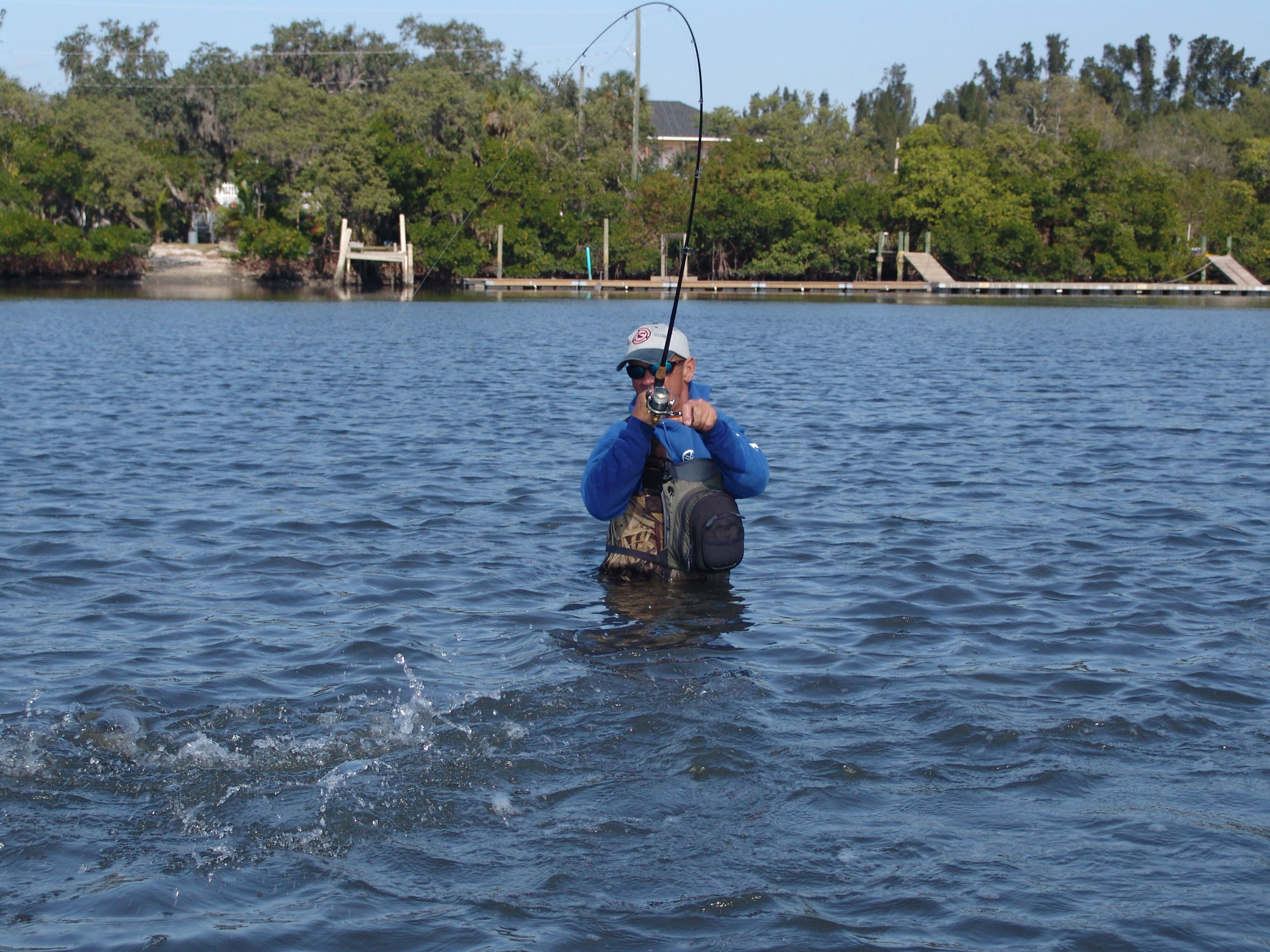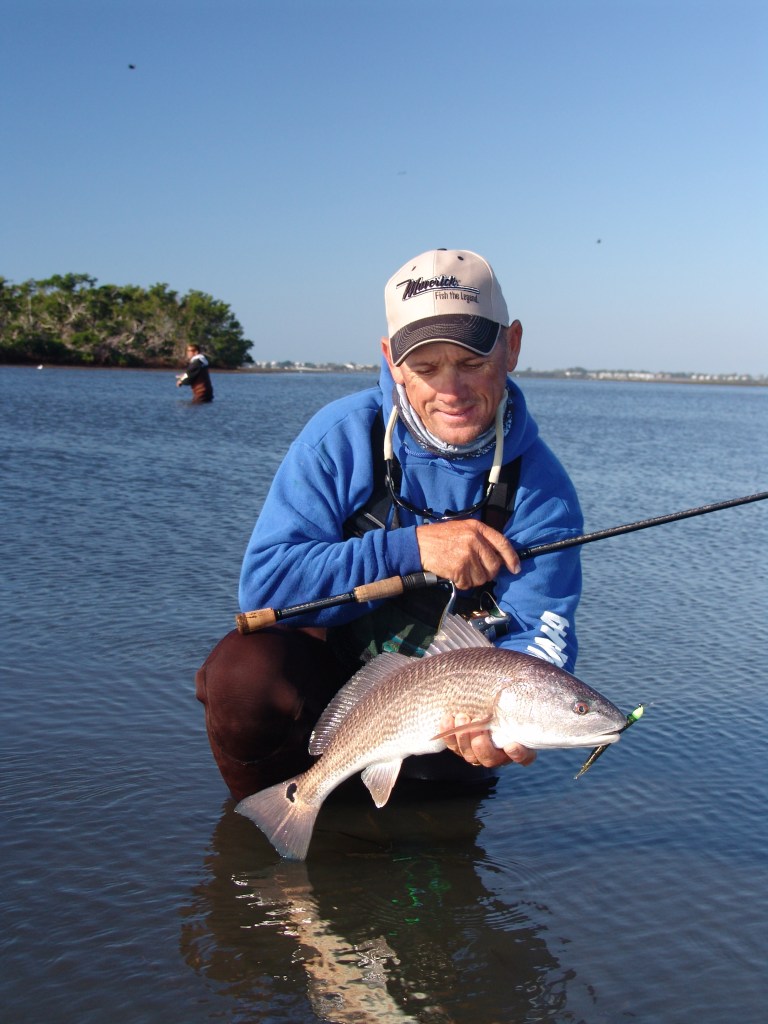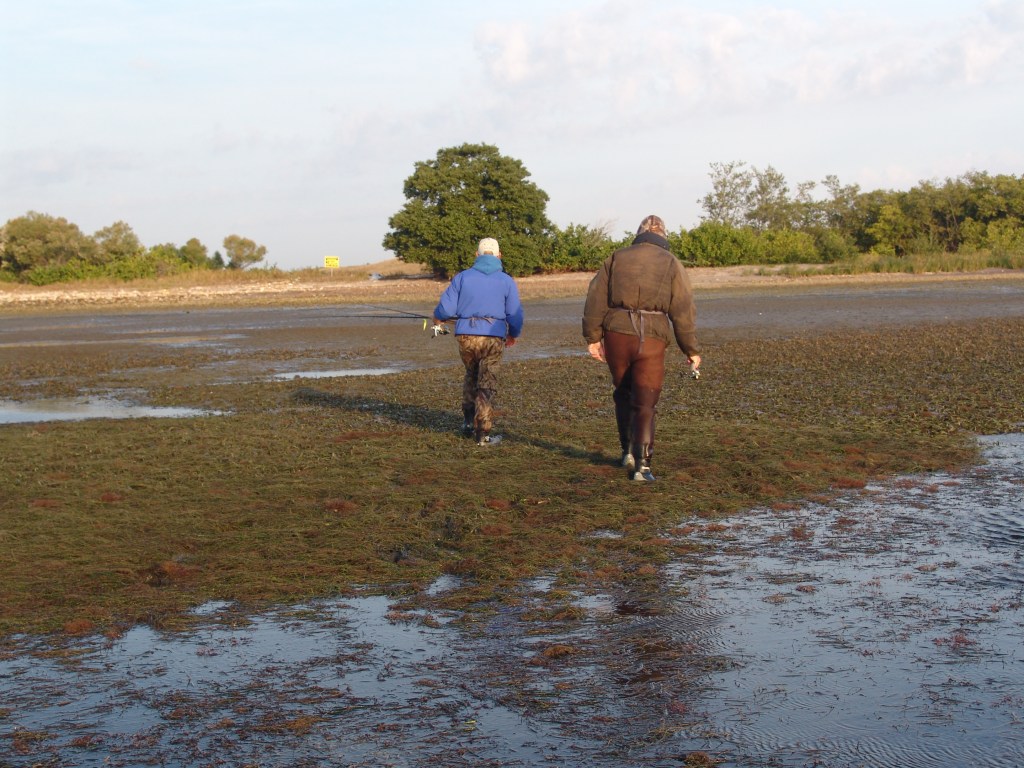
The popular motivational statement encourages: “Don’t wait for your ship to come in, swim out to it.”
Now, replace “ship” with “tide,” then replace “swim” with “wade” and you have the premise that rewards intrepid Gulf Coast anglers with top-tier cold season fishing action. Redfish, speckled trout and snook (Florida and South Texas) remain active in varying degrees throughout the winter months, but stepping into their environment often is the best way to make their acquaintance.
Now, it might sound counterintuitive that the fish would favor shallow water during the colder months, but we have to look at the big picture. First, the term “shallow” is relevant and more importantly, where the fish go is not entirely their decision.
In truth, winter tidal patterns often create incredible opportunities for those willing to blend a little hiking with their fishing.
Nature’s curtain call
Winter tides generally fall lower than they do in the warm season, while new and full moons exert even greater impact. This extra pull drags the lows far enough to limit boat access to inner bays and backwaters, but mitigating factors often exaggerate the scenario.
In short, when new and full moon cycles align with a cold front, the hard north wind pushes the water even lower and holds it out longer. The resulting “negative low tides” drain vast areas and any fish that missed the exit call will settle into the random holes and troughs tucked far from navigable depths.
With a host of inshore game fish piling into backwater pools that remain isolated by outer bars, it’s a briny treasure hunt well worth the explorative effort. The only way to reach the bounty of mostly unpressured fish is on foot. You can motorboat or paddle to the perimeters, but stepping into the chilly brine gives you a front row seat to incredible winter action.

Spot the signs
Once you’re in the water, the sunny days common to post-frontal conditions help you spot the lighter sand holes amid the darker grassy bottom. Oyster bars typically stand mostly exposed, but there’s always a deeper end/side, so focus on the obvious fish magnets.
Before you step in, electronic mapping will show you the depth zones and approach/retreat lanes, along with relevant proximities from the isolated pools to deeper open water. Note the logical areas where fish will likely funnel into and out of the low-tide refuges.
Also, note the sharp dropoffs, drains, points, etc., where fish might gather as the extreme low water levels finally start to subside.
Think: Black Friday sale, but instead of low-cost air fryers, watches and big screen TVs, the fish want those shrimp, crabs and worms stranded atop the drained flat. Soon as the (tidal) door opens, it’s a mad rush to the goodies.
Worth a note: During a past wading trip in South Tampa Bay, a buddy and I found a flat that had drained so quickly, several shrimp were left flipping amid the wet grass. As we watched sea gulls picking off the crustacean snacks, I mentally noted the relationship between spotting these and other sea birds walking exposed winter flats.
Those particular shrimp didn’t last long, but such sights clearly indicate fertile areas.
Later, when the tide started to sneak in, we could see redfish pushing water near a shallow slide-off. Apparently, this was their preferred flat entry, and while we caught a couple from the waiting room, we probably would’ve wrecked ‘em if we had stuck around long enough for the tide’s return.
Something else to note — mullet. These ambling vegetarians displace crustaceans and finfish forage, so when they appear in your low-tide sanctuaries, you can bet that redfish, trout and sometimes snook will follow closely.
Mullet schools also provide cover/concealment. That means predators swimming with the school benefit from the “safety in numbers” premise when ospreys, eagles or dolphins threaten.
Also, because mullet pose no threat to the pinfish, shrimp and crabs, any trout, redfish or snook rolling with them can easily burst forth to grab unsuspecting prey. Lastly, the noise and commotion of the decidedly ungraceful mullet disguises the sound of lures dropping close.

Top tactics
Once the fish have spent a few hours in their low-tide isolation, any pickiness goes bye-bye. That means a broadly receptive audience, but prudent bait selection still matters.
If you like easy pickings, rig a live shrimp under a cork and it’s going to happen pretty quickly. Just consider the bait bucket you’ll need to tie to your waist. Buoyant wading caddies like the Seamule help, but consider the entanglement risk and keep your hooked fish clear of the tether.
Artificials streamline the operation and allow you to more thoroughly cover your available depths to find fish concentrations. Topwaters can prove amazingly productive, especially when mullet are present. Just avoid casting directly into a school, as these neurotic fish spook easily and when they bolt, they take the game fish with them.
Light jigheads are one of the most versatile wading options, as you can quickly alter body shape, size and color in response to conditions or fish behavior. Cast and retrieve with small paddle tails, or hop and twitch jerkbaits or crustacean imitators.
Artificial shrimp like the LIVETARGET rigged shrimp, Z-Man’s new PrawnstarZ or the original DOA Shrimp, offer similar simplicity. A slow twitch-and-fall cadence usually does the trick, but don’t let the bait sink into the entangling grass.
Weedless gold, silver or natural-colored spoons cast well in windy conditions and mimic pinfish and other baitfish flashing through grassy bottom. Particularly tempting to redfish, spoons also traverse rock or shell bottom better than jigs.
Lastly, a user-friendly technique that appeals to beginners and seasoned anglers alike, the popping cork blends fish-attracting commotion with a clear strike indicator, while keeping your bait suspended above snaggy bottom. Simply hang a jig or an artificial shrimp below the cork, chug the rig a few times to mimic feeding and let it rest until a hungry fish spots the suspended bait.

Comfort and safety
Insulated chest waders are a must, and don’t skimp on this step. Standing even waist deep in winter water can become unbearable with cheap waders. You can always roll the top down (in shallow areas) if you overheat, but you’ll never regret a little overkill when temperatures plummet.
Boot-foot waders work for solid bottoms, but if you’ll be wading through mud and muck, go with stocking-foot waders with independent wading boots. Important: Go a size or two larger than you’d normally wear to allow for wader bulk.
Soft bottom has a strong grip and your foot might slip out of boot-foot waders before the actual boot emerges. This imbalance could cause a fall, while external wading boots laced tightly will hold their place.
Situational awareness: The distance you walk from your boat is the same distance you’ll have to cover when you’re done fishing. That’s pretty straightforward, but one of the biggest surprises novice waders encounter is a hole or trough that’s significantly deeper during the return trip.
Anyone who’s ever tip-toe hopped through a deep spot while the water level threatened wader encroachment holds a new understanding of the term “pucker factor.”
Agility: Just like a swimming pool, the seawater will support your body, but don’t get complacent with your balance. Make every step count, don’t get in a hurry and pay attention to shifting bottoms.
Oyster bars merit particular concern, as loose clumps can suddenly slip and send you tumbling. Again, measured steps.
Also, from personal (nearly, ahem, “eventful”) experience, I caution anglers wading near inshore channel or creek edges to maintain a safe distance. I hooked a nice redfish in an 8-foot creek draining a mangrove basin and nearly allowed the excitement to distract me from the fact that outgoing water was whittling the sand from beneath my right foot.
Preparation: When you’re fishing knee-deep brine, taking a tumble in waders usually amounts to little more than an inconvenience, but when the water’s waist high or deeper, a fall could turn tragic. Cold water can cause hypothermia, but even more threatening is the sudden anchoring effect of flooded waders.
Waist belts that cinch waders tight will limit water intrusion, but experienced types always keep a knife in close reach. If the unthinkable happens, cutting open your waders can be the difference maker. The water’s still going to be cold, but at least you’ll have better survival chances than finding yourself pinned under the surface.
Endurance: When wading on firm sand, water resistance will definitely give you a workout, but nothing like the soft, mucky bottom near creek mouths. Imaging walking through a vat of oatmeal.
Tampa Bay, for example, holds several hidden lagoons deep within mangrove basins and accessible only by wading or paddling through canopied tunnels. The protected inner waters can offer stellar action, but make sure you’re up for the exhausting approach through soft bottom.
Wherever you wade for winter fish, carry water inside your waders or a light backpack. Strategic option: AFTCO’s Urban Angler Backpack conveniently blends tackle storage with a hydration pack.
Lastly, use a dry bag or a Ziploc to keep cellphone, keys, wallet, etc., tucked safely inside your waders. Also, a hand towel held in a separate waterproof bag keeps fingers dry and clean for snapping those wading selfies.





